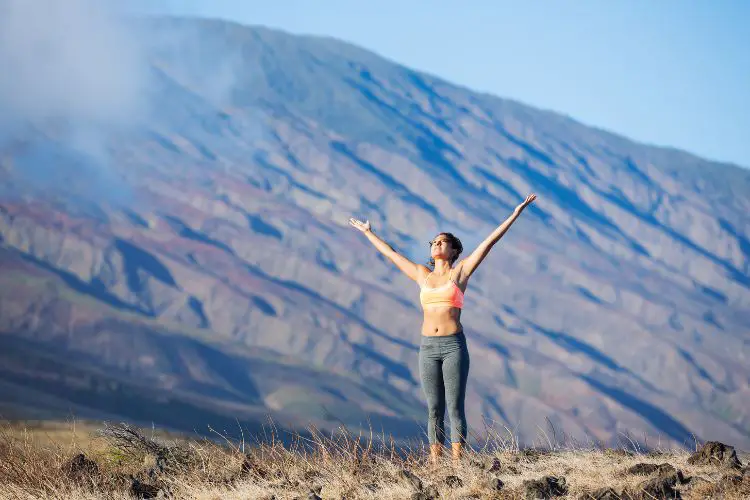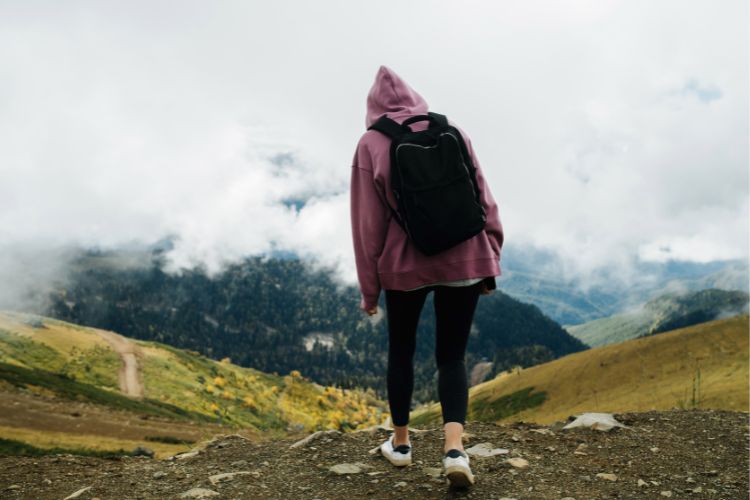When it comes to choosing the perfect attire for hiking adventures, the options can be as diverse as the trails themselves.
While hiking-specific gear exists, many wonder if yoga pants, known for their comfort and flexibility, are suitable for hitting the trails.
In this article, we will explore the pros and cons of wearing yoga pants for hiking and provide tips on when they can be a viable option.
Contents
The Pros of Yoga Pants for Hiking
Yoga pants have gained popularity as a comfortable and versatile option for outdoor enthusiasts.
In this section, we will explore the advantages of using yoga pants for hiking, highlighting their unique features that contribute to a comfortable and flexible hiking experience.
1. Lightweight and Breathable Materials

Yoga pants, just like leggings, are often made from lightweight, breathable materials like nylon, polyester, or spandex blends.
These fabrics help keep you comfortable by allowing airflow and preventing overheating, making them an excellent choice for hiking in warm weather.
2. Flexibility and Freedom of Movement
The stretchy nature of yoga pants provides exceptional flexibility, allowing you to navigate challenging terrain with ease.
Whether you’re crossing streams, scrambling over rocks, or maneuvering through tight spots, yoga pants move with your body, reducing restrictions and discomfort.
3. Moisture-Wicking Properties

Many yoga pants are designed with moisture-wicking technology, which efficiently manages sweat.
These specialized materials pull moisture away from your skin, keeping you dry and preventing chafing even during intense hikes in hot and humid conditions.
4. Quick Drying
Yoga pants designed with quick-drying properties ensure that if you encounter unexpected rain or creek crossings during your hike, they won’t stay damp for long.
This feature helps maintain your comfort by preventing prolonged exposure to wet fabric, especially in changing weather conditions.
5. Comfortable Waistbands

Yoga pants often feature wide and comfortable waistbands that stay in place during physical activity.
This ensures that your pants won’t slip down or cause discomfort, even during extended hikes.
Cons of Using Yoga Pants for Hiking
While yoga pants offer several benefits, they also come with limitations that may not suit every hiking scenario.
In this section, we will delve into the drawbacks of using yoga pants for hiking, helping you understand when they may not be the best choice for your outdoor adventures.
1. Durability Concerns
Yoga pants are typically made from thinner and more delicate materials compared to traditional hiking pants.
Consequently, they may be more susceptible to tears and damage when exposed to rough terrain, sharp rocks, or thorny bushes.

The materials used in yoga pants are designed for flexibility and comfort, but they may not withstand the abrasion and wear and tear associated with challenging hiking environments.
2. Limited Storage Options
Unlike hiking pants with numerous pockets and cargo features, yoga pants usually have minimal storage.
If you rely on pockets to carry essential items such as maps, a compass, a multi-tool, or energy snacks, you may find yourself needing to use a backpack or alternative storage solutions.
This can be less convenient, as it may require additional equipment and could affect your mobility.
3. Weather Sensitivity
Yoga pants are primarily designed for indoor or mild-weather use. They may not provide sufficient insulation or protection against cold, windy, or wet conditions.

When hiking in adverse weather, such as rain or cold temperatures, traditional hiking pants with waterproofing and thermal properties are a better choice for comfort and safety.
When Are Yoga Pants Suitable for Hiking?
Yoga pants can be a practical choice for certain hiking conditions, providing hikers with comfort and flexibility. In this section, we will specify the scenarios and hiking situations where yoga pants excel, ensuring that you make an informed decision for your next trek in the great outdoors.

- Easy Trails: Choose yoga pants for well-maintained trails with minimal obstacles, as they offer the comfort and flexibility required for leisurely walks in nature.
- Short and Casual Hikes: For shorter and less strenuous hikes, such as those lasting a few hours or less, yoga pants can provide the comfort and freedom of movement needed without compromising on style.
- Warm Weather Hiking: Yoga pants excel in warm weather conditions due to their breathability and moisture-wicking properties. They help keep you cool and dry on sunny, balmy hikes, enhancing your overall comfort.
- Low-Intensity Activities: If you plan to incorporate low-intensity activities like stretching or yoga into your hike, yoga pants are a suitable choice, offering the flexibility needed for these exercises.
Conclusion
Are yoga pants good for hiking? The answer depends on various factors, including the type of hike, weather conditions, and personal preferences.
While yoga pants offer comfort and flexibility, they may not provide the protection and durability required for more challenging treks.
Before heading out on your next hike, carefully consider the specific demands of the trail and choose your clothing accordingly.
Remember that safety and practicality should always be your top priorities to ensure an enjoyable and safe hiking experience.

